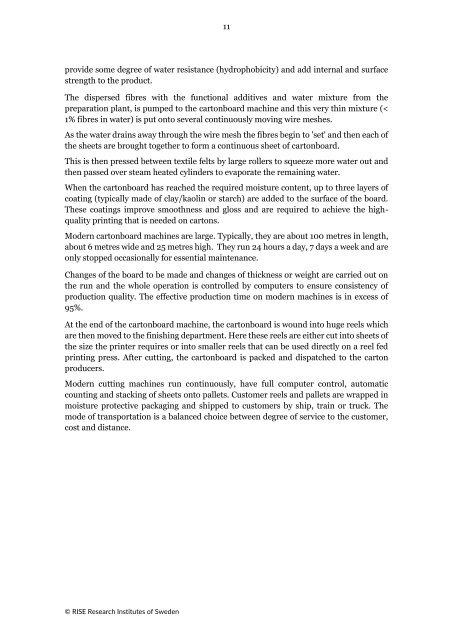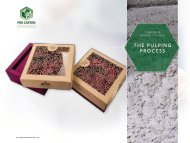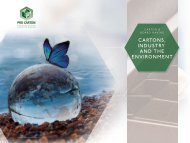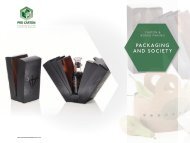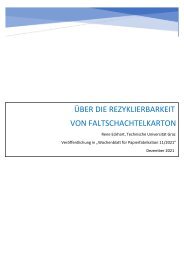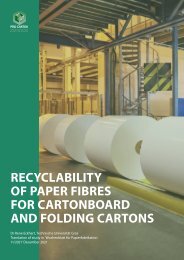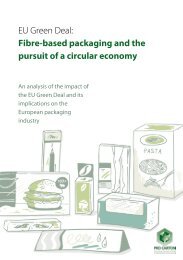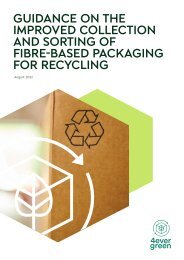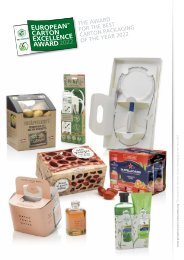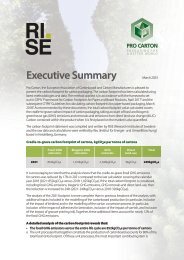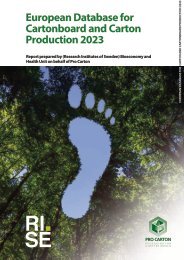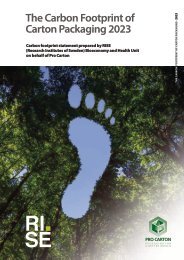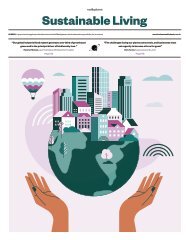European database for cartonboard and carton production, 2023
You also want an ePaper? Increase the reach of your titles
YUMPU automatically turns print PDFs into web optimized ePapers that Google loves.
11<br />
provide some degree of water resistance (hydrophobicity) <strong>and</strong> add internal <strong>and</strong> surface<br />
strength to the product.<br />
The dispersed fibres with the functional additives <strong>and</strong> water mixture from the<br />
preparation plant, is pumped to the <strong><strong>carton</strong>board</strong> machine <strong>and</strong> this very thin mixture (<<br />
1% fibres in water) is put onto several continuously moving wire meshes.<br />
As the water drains away through the wire mesh the fibres begin to 'set' <strong>and</strong> then each of<br />
the sheets are brought together to <strong>for</strong>m a continuous sheet of <strong><strong>carton</strong>board</strong>.<br />
This is then pressed between textile felts by large rollers to squeeze more water out <strong>and</strong><br />
then passed over steam heated cylinders to evaporate the remaining water.<br />
When the <strong><strong>carton</strong>board</strong> has reached the required moisture content, up to three layers of<br />
coating (typically made of clay/kaolin or starch) are added to the surface of the board.<br />
These coatings improve smoothness <strong>and</strong> gloss <strong>and</strong> are required to achieve the highquality<br />
printing that is needed on <strong>carton</strong>s.<br />
Modern <strong><strong>carton</strong>board</strong> machines are large. Typically, they are about 100 metres in length,<br />
about 6 metres wide <strong>and</strong> 25 metres high. They run 24 hours a day, 7 days a week <strong>and</strong> are<br />
only stopped occasionally <strong>for</strong> essential maintenance.<br />
Changes of the board to be made <strong>and</strong> changes of thickness or weight are carried out on<br />
the run <strong>and</strong> the whole operation is controlled by computers to ensure consistency of<br />
<strong>production</strong> quality. The effective <strong>production</strong> time on modern machines is in excess of<br />
95%.<br />
At the end of the <strong><strong>carton</strong>board</strong> machine, the <strong><strong>carton</strong>board</strong> is wound into huge reels which<br />
are then moved to the finishing department. Here these reels are either cut into sheets of<br />
the size the printer requires or into smaller reels that can be used directly on a reel fed<br />
printing press. After cutting, the <strong><strong>carton</strong>board</strong> is packed <strong>and</strong> dispatched to the <strong>carton</strong><br />
producers.<br />
Modern cutting machines run continuously, have full computer control, automatic<br />
counting <strong>and</strong> stacking of sheets onto pallets. Customer reels <strong>and</strong> pallets are wrapped in<br />
moisture protective packaging <strong>and</strong> shipped to customers by ship, train or truck. The<br />
mode of transportation is a balanced choice between degree of service to the customer,<br />
cost <strong>and</strong> distance.<br />
© RISE Research Institutes of Sweden


